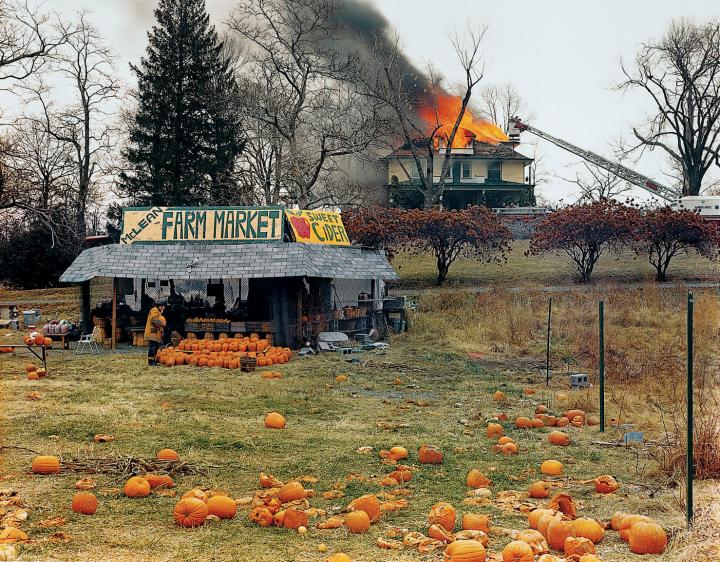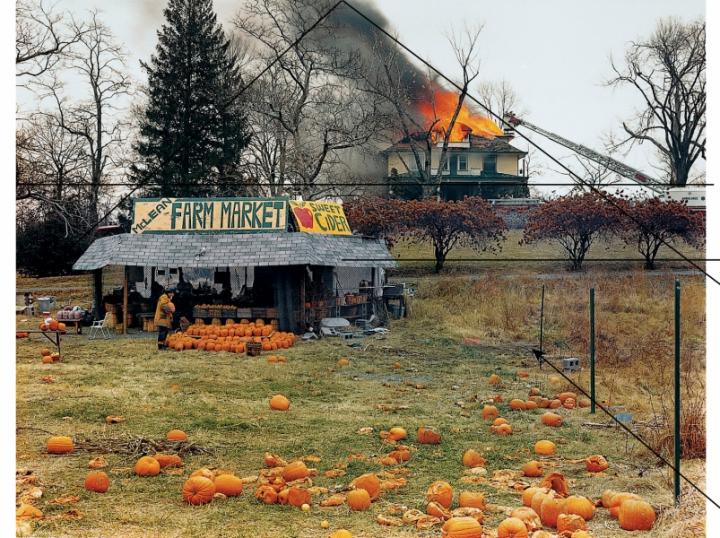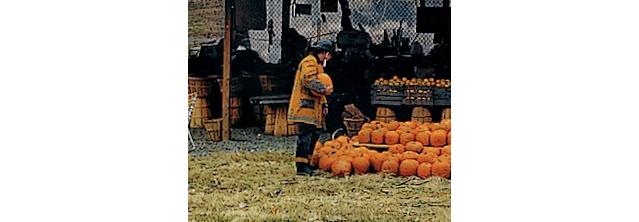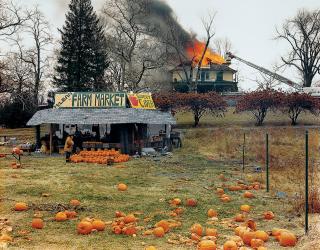
Joel Sternfeld, McLean, Virginia (Pumpkins), December 1978, dye transfer print. Gift of Joel Sternfeld, Class of 1965, and Neil Grossman, Class of 1965, in memory of John Pickells, Class of 1965; PH.986.24.
Based on the Learning to Look method created by the Hood Museum of Art. This discussion-based approach will introduce you and your students to the five steps involved in exploring a work of art: careful observation, analysis, research, interpretation, and critique.
HOW TO USE THIS RESOURCE
1. Print out this document for yourself.
2. Read through it carefully as you look at the image of the work of art.
3. When you are ready to engage your class, project the image of the work of art on a screen in your classroom.
4. Use the questions provided below to lead the discussion.
Step 1. Close Observation
Ask students to look carefully and describe everything they see. Start with broad, open-ended questions like:
* What do you see or notice about this photograph?
* What else do you see?

Become more and more specific as you guide your students’ eyes throughout the work with questions like these:
* What do you see in the background?
- The middle ground?
- The foreground?
* What do you notice about the people in this photograph? What are they doing?

* What do you notice about the composition or arrangement of this photograph?
* What lines do you see? What shapes do you see?
* What leads your eye into the background?
* What do you notice about the colors?
Step 2. Preliminary Analysis
Once you have listed everything you can see about the object, begin asking simple analytic questions that will deepen your students' understanding of the work.

For instance:
* What time of year is it in this photograph?
* Where in the world was it taken?
* Was it taken recently or long ago?
* What seems to be going on in this photograph?
* How does this photograph make you feel?
After each response, always ask, “How do you know?” “How can you tell?” or “What makes you say that?” so that students will look to the work for visual evidence to support their theories.
Step 3. Research
At the end of this document, you will find some background information on this object. Read it or paraphrase it for your students.
When you have finished sharing the information, consider the following:
* Does this information reinforce what you observed and deduced on your own?
* Did it mention anything that you did not see or think about previously? If so, what?
* How would your experience of this photograph have been different if you had read the background information first?
Step 4. Interpretation
Interpretation involves bringing your close observation, preliminary analyses, and any additional information you have gathered about an art object together to try to understand what a work of art means. There are often no absolute right or wrong answers when interpreting a work of art. There are simply more thoughtful and better informed ones. Challenging your students to defend their interpretations based upon their visual analysis and their research is most important.
Some basic interpretation questions for this object might be:
* When we see photographs, we tend to think of them as representing the truth– something that actually happened. How is this photograph intentionally misleading?
* Why does Joel Sternfeld want to mislead us with his photograph? What does he want us to think about photography?
* What other "truths" does this photograph ask us to question–perhaps about fall in the country, the heroism of firemen, or our response to fire?
Step 5. Critical Assessment and Response
Critical assessment and response involves a judgment about the success of a work of art. This step optional but should always follow the first four steps of the Learning to Look method. Art critics often engage in this further analysis and support their opinions based on careful study of and research about the work of art.
Critical assessment involves questions of value. For instance:
* Do you think Joel Sternfeld accomplished what he set out to do? Is this a successful photograph? Why or why not?
This fifth stage can also encompass one’s response to a work of art. One’s response can be much more personal and subjective than one’s assessment.
* Do you like this photograph? Why or why not?
* Do you think this photograph’s message is relevant? Why or why not?

Background Information
Joel Sternfield, American, born 1944
McLean, Virginia, 1978
Dye transfer print
Gift of Joel Sternfeld, Class of 1965, and Neil Grossman, Class of 1965, in memory of John Pickells, Class of 1965; PH.986.24
This photograph by Joel Sternfeld is from his project American Prospects, a photographic tour of America, published in 1987. This project involved a search for the essence of America, not as it exists in any particular era but simply as it is. The photographs together are rather sad but also funny and generous, recognizing endurance, beauty, and determination within the sometimes tense, often ironic juxtapositions of man and nature, technology and ruin.
In crystal clear and brilliant color, Joel Sternfeld captured with an eight-by-ten-inch camera images of everyday scenes caught in surreal moments. The destructive fire that sets the scene for a fireman perusing pumpkins for purchase in McLean, Virginia is one such image. The photograph seems to show a fireman nonchalantly ignoring a crisis. In fact, he is merely taking a break from a carefully orchestrated training exercise. The image is humorous but at the same time slightly disturbing. The careful composition of this photograph, with its strong, central pyramid anchored by repeating horizontal lines and vibrant oranges, gives the event a weight and monumentality that the real situation does not warrant.
Representative of a group of photographers working in the 1970s who took a less idealized approach to nature and culture, Sternfeld challenges us to consider the "truth" of documentary photography and our ideas about the modern American landscape. As Sternfeld commented, "It's been very fashionable to focus on the weakness and the banality of America, but what I wanted to say is that it's also a very exciting and fascinating place."